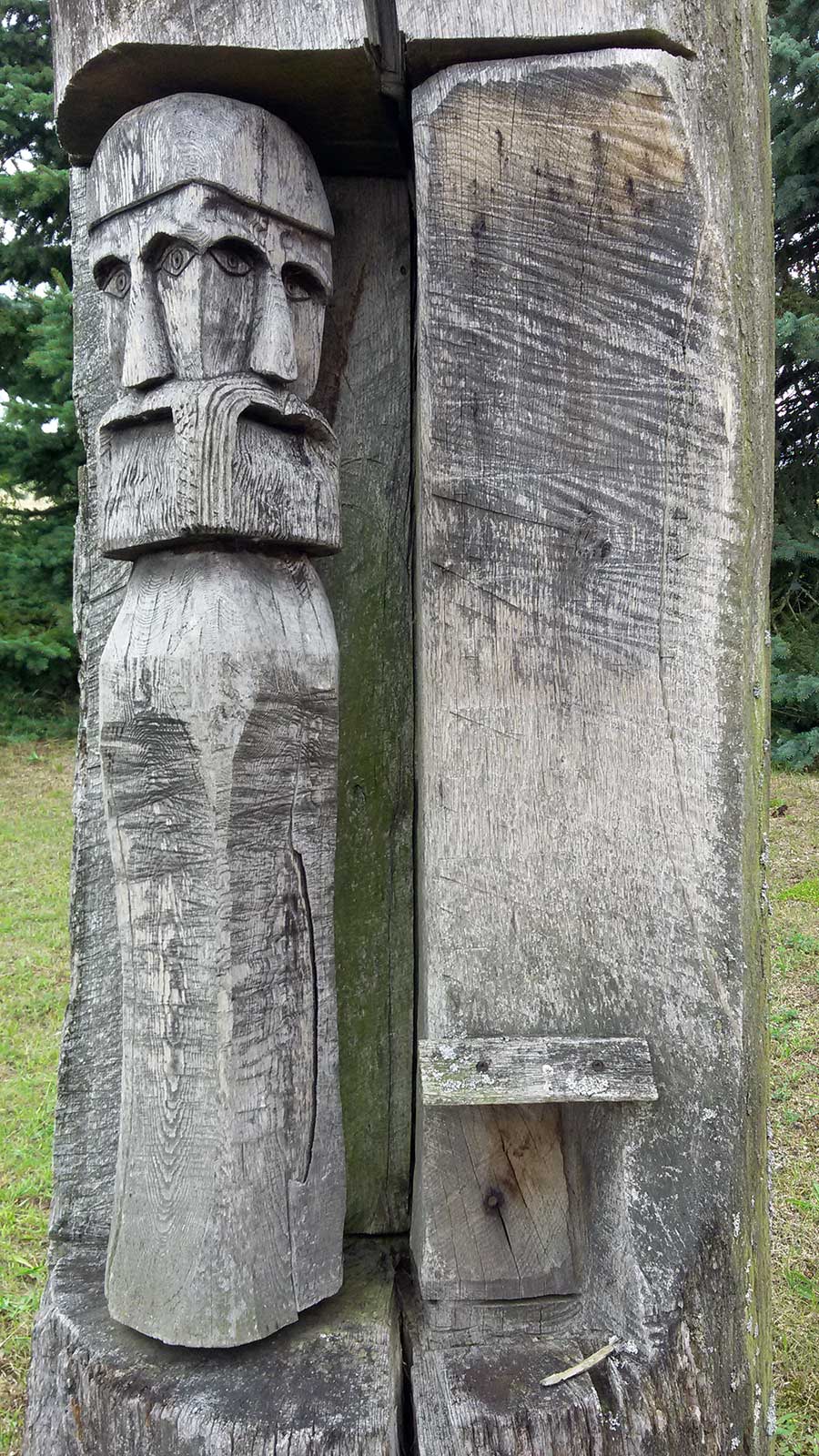 The aim of this text is to present early medieval miniature figurines discovered in the Baltic Sea region. The authors review interpretations of this archaeological finds from literature and offer a new perspective for their functions. The next problem dealt with is the ethno-cultural membership of the users of the objects.
The aim of this text is to present early medieval miniature figurines discovered in the Baltic Sea region. The authors review interpretations of this archaeological finds from literature and offer a new perspective for their functions. The next problem dealt with is the ethno-cultural membership of the users of the objects.
We would consider those figurines as symbols or perhaps fetishes referring to a particular sacral power, perhaps associated with the four-faced god Svantevit(?), or as ritual requisites connected with magic practices (especially in the form of vegetation magic and love magic). The representations of four faces or four heads on these objects may have legitimized the creative power of these objects, i.e. a power sanctioned by the authority of a deity with particular competence. Consequently, in our view, the multi-faced figures found in different locations within the Baltic Sea area would suggest a Slavic presence.
The notion of small anthropomorphic or zoomorphic objects associated with the sphere of military or economic activities of early medieval societies remains problematic. Such artefacts are only sporadically discussed in the academic literature, and they are often overshadowed by much larger research topics. In the majority of cases, anthropomorphic or zoomorphic artefacts are interpreted as being associated with a religion or cult, or with the practical spheres of everyday life and perceived as toys. However, a closer analysis of all such artefacts reveals that their nature is much more complex and requires a wider study.
In our analysis of the so-called miniature idols from the Baltic Sea area, we will attempt to provide answers to the three, in our view, most intriguing notions. We will first consider whether the presence of such objects at various archaeological sites may imply intercultural contacts, or whether they were a supra-cultural phenomenon. Secondly, we will examine whether the production and use of such figures could be associated with a particular ethnos. The third and most significant notion that will be considered herewith concerns the symbolic values and meanings with which such objects may have been endowed.
In order to attempt at providing answers to these research questions, it is necessary to first provide a catalogue of all known finds of such miniature idols.
The best-known anthropomorphic miniature idol is a four-faced figure/statue interpreted by its excavators as a representation of the Slavic god Svantevit (pl. Światowid). The object is 9.3 cm high and has a “handle” in the form of a four sided, flat tang with a semi-circular bottom. It was found in layer XIV in trench no 6 during the archaeological excavations in the early medieval Wolin (Western Pomerania, Northern Poland). The miniature idol was discovered beneath the floor of a house dated to the 11th century (Filipowiak 1988: 89; 1993: 29), which stood nearby another building interpreted as a kącina (pagan temple).[1] The miniature idol was dated to the second half of the 9th century based on its find-context. The upper part of the find comprises four faces, each of them facing another direction. The lower part of the find, in the form of a “tang” or “handle” was ornamented with poorly visible incisions in the form of oblique lines and ovals (Filipowiak, Wojtasik 1975: 84–85).
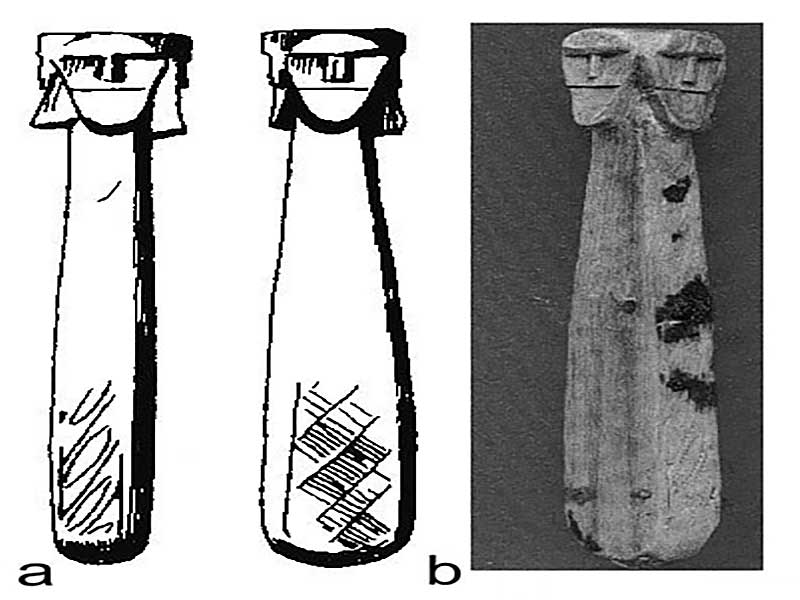 Svantevith from Wolin. After: a) Filipowiak, Gundlach 1992; b) Europas 2000, p. 138 fig. 05.01.08
Svantevith from Wolin. After: a) Filipowiak, Gundlach 1992; b) Europas 2000, p. 138 fig. 05.01.08
Featured image from Wolin was found inside a house, which probably burned down. The sculpture was discovered in a layer that contained wood shavings, mulch and other debris associated with economic activities – all of which enabled its good preservation. According to the excavators’ interpretation, this figurine was lost or trampled into the ground during its owners’ escape from the burning house (Filipowiak, Wojtasik 1975: 85–86).
From the younger settlement phase in Wolin (1st half of the 10th century) comes yet another interesting find. It was discovered in the remains of one of the houses and had a form of an “idol” with a transverse hob, which gave it a shape in the form of the letter “T”. However, in contrast to the other finds discussed above, this idol did not have a face (Filipowiak 1993: 29) and according to Filipowiak and Wojtasik it may have been an unfinished sculpture. In our view, this interpretation seems difficult to sustain, as the upper part of the sculpture is too small to sculpt a face. We also disagree with the interpretation of Filipowiak and Wojtasik according to whom this was a “cult object in a simplified form” (Filipowiak, Wojtasik 1975: 86).
The closest parallel to the figure of Svantevit from Wolin is a miniature from Svendborg in Jutland (Denmark). This 13-cm high sculpture was made from juniper and dates to the 12th century (Filipowiak 1993: 29; Müller-Wille 1999: 84). It has a form of a “handle” with a sharp end. In its upper part it bears a representation of four interconnected faces, each with a triangular-shaped beard. All four faces are crowned with a single head covering resembling a hat with a flat top. According to Lamm (1987: 226) this item does not represent a four-faced being (as we would assume) but rather a three-headed one. In our opinion, Lamm’s interpretation of this find may result from an attempt at associating it with supernatural beings from the Old Norse mythology where no four-headed beings can be found. We will return to this notion further below.
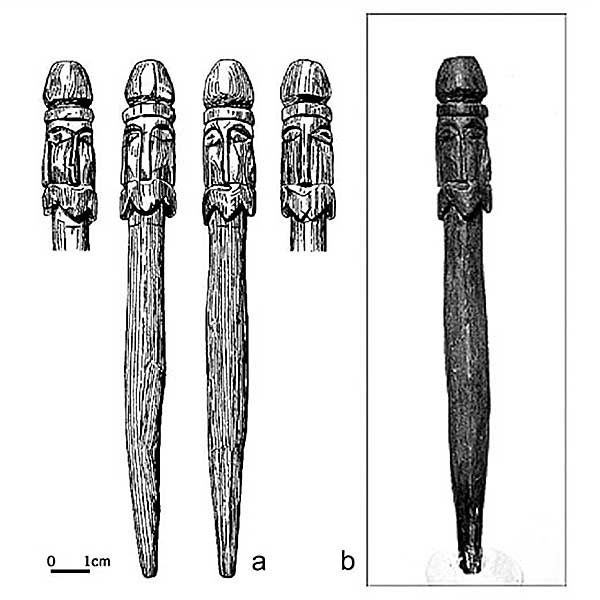 Svendborg figure. After a) Muhl 2012, fig. 5; b). Filipowiak 1993, p. 31, fig. 13.
Svendborg figure. After a) Muhl 2012, fig. 5; b). Filipowiak 1993, p. 31, fig. 13.
Two other figures of a similar type have also been found in Scandinavia. The first of these was discovered in Tunby in Västmanland, Sweden in a female cremation grave dated to the 10th century (Duczko 2000: 39). It was manufactured from bone and its “handle” was decorated with a delicate ornament. The oval faces, although poorly preserved, are more realistically carved than in the case of the examples discussed above. Their shape is oval and their beards are triangular. All along the longer axis of the figure there is a hole, which according to Lamm (1987: 228), implies that the item was originally used as an awl.
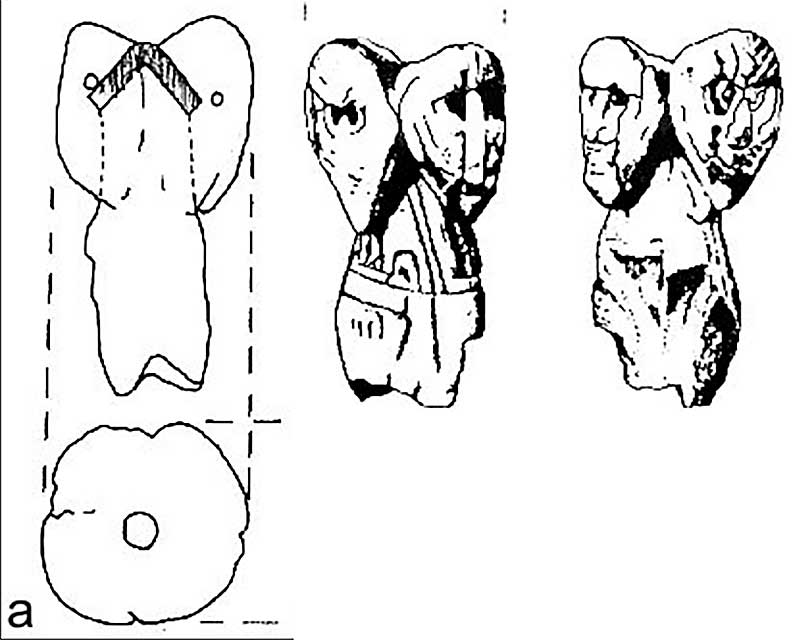
Tundby figure. After Duczko 2000, p. 38, fig. 12.
The second figure was also discovered in a cremation grave dated to the 10th century at a cemetery in Väsby in Uppland, Sweden (Lamm 1987: 229). Like the find from Tunby, this object was also made from bone and its handle was decorated with a rich ornament whose form resembles a net, with sharp triangles at its bottom. Artefacts decorated in such a way are typical for the Pomeranian emporium in Wolin and, according to Duczko (2000: 39), the object from Väsby was actually produced there. The upper part of this figure contains two oval-shaped faces with schematically carved noses, eyes and moustache. Originally, the figure contained four faces, but they broke off and the places from which they broke can be clearly seen on the figure’s surface.
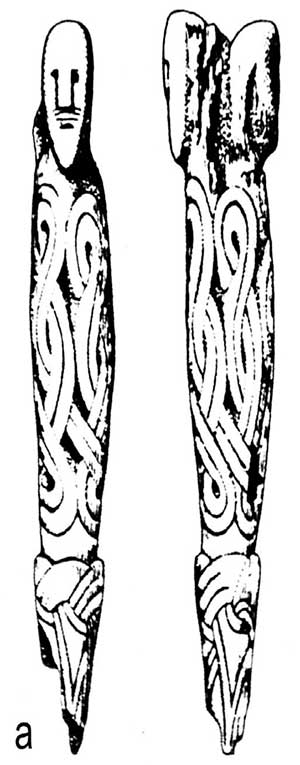 The last find worthy of attention is a wooden figure from Riga in Latvia. This object is 13 cm long and contains a representation of two bearded male heads. Originally, just like the figure from Väsby, the find from Riga probably had four faces. The two faces have clearly demarcated eyes and noses, but also moustaches and long hair. Once again, we may observe a very schematic representation of a head-covering (Caune 1995: 26-27). In the mid-part of the figure, there is an ornament consisting of two parallel “wavy-lines”, separated by a horizontal line. At the lower-end of the find, there is a schematic representation of an animal head with large eyes and a clearly shown upper part of its snout (Caune 1995: 28-29). This object was dated to the first phases of the 13th century. Interestingly, another 31-cm long object with the representation of four faces was found in the same chronological context. Although it is often seen as a parallel find to the abovementioned figure from Riga, in our view it should rather be seen as the head of a walking stick; therefore, we will refrain from associating it with the multi-headed figures discussed in this paper.
The last find worthy of attention is a wooden figure from Riga in Latvia. This object is 13 cm long and contains a representation of two bearded male heads. Originally, just like the figure from Väsby, the find from Riga probably had four faces. The two faces have clearly demarcated eyes and noses, but also moustaches and long hair. Once again, we may observe a very schematic representation of a head-covering (Caune 1995: 26-27). In the mid-part of the figure, there is an ornament consisting of two parallel “wavy-lines”, separated by a horizontal line. At the lower-end of the find, there is a schematic representation of an animal head with large eyes and a clearly shown upper part of its snout (Caune 1995: 28-29). This object was dated to the first phases of the 13th century. Interestingly, another 31-cm long object with the representation of four faces was found in the same chronological context. Although it is often seen as a parallel find to the abovementioned figure from Riga, in our view it should rather be seen as the head of a walking stick; therefore, we will refrain from associating it with the multi-headed figures discussed in this paper.
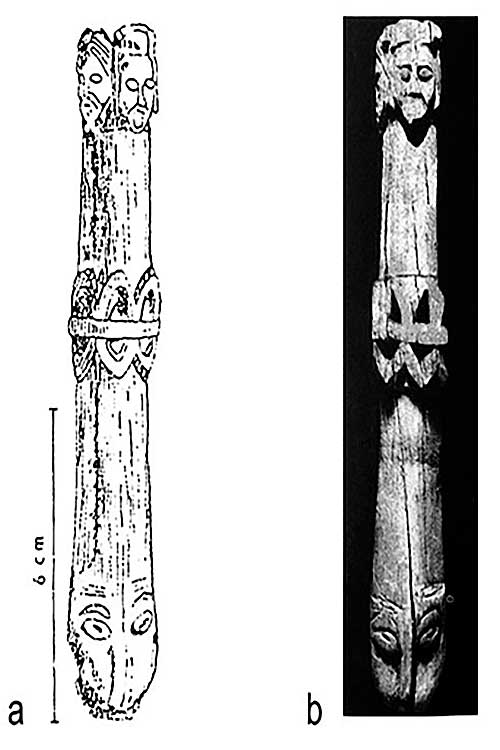 Based on the archaeological materials examined above, it is possible to assume that the multi-headed figures appear in different areas at the Baltic coast: from Stockholm in the north to Wolin in the south, Riga in the east and Svendborg in the west. The chronology of these finds is broad: between the 9th and the beginnings of the 13th century.
Based on the archaeological materials examined above, it is possible to assume that the multi-headed figures appear in different areas at the Baltic coast: from Stockholm in the north to Wolin in the south, Riga in the east and Svendborg in the west. The chronology of these finds is broad: between the 9th and the beginnings of the 13th century.
In the academic literature, such artefacts are usually interpreted as amulets (Kotlarczyk 1993: 56-57), small idols associated with domestic (private) cult (Filipowiak 1993: 33) or, as in the case of the find from Svendborg, as “travel-figures” (Filipowiak 2001: 100-101). Recently, an alternative interpretation was proposed by Wawrzeniuk (2004), who argued that such figures may have represented deceased ancestors, whose cult was allegedly one of the basic features of pre-Christian Slavic beliefs. This proposal, however interesting, does not withstand criticism and the arguments offered by Wawrzeniuk seem to have very weak foundations.
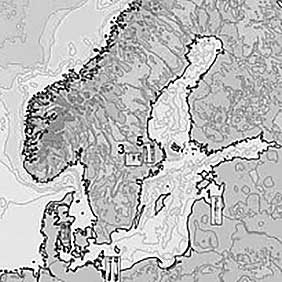 After this introduction and after the presentation of the archaeological source material, we would like to concentrate on two other recently proposed attempts at interpreting these peculiar “miniature idols”. In the first attempt, the archaeological material was confronted with written accounts and the miniature idols were divided into two categories (Kajkowski in press).
After this introduction and after the presentation of the archaeological source material, we would like to concentrate on two other recently proposed attempts at interpreting these peculiar “miniature idols”. In the first attempt, the archaeological material was confronted with written accounts and the miniature idols were divided into two categories (Kajkowski in press).
The first category comprised finds made from non-ferrous metals in the form of anthropomorphic figures that may be interpreted as representations of pagan gods. From the area of Pomerania, only one such object is known. Ebo (II, 13), who was one of the biographers of St. Otto of Bamberg, describes in his account a golden figure of the god Triglav (Pl. Trygław), which was secretly transported from Szczecin during the Christianization mission. According to Ebo, the pagan priests gave it to a certain widow that lived in a village, whose name – sadly – remains unknown. As we read in Ebo’s account:
Tempted by the payment, she protected the godless image in such a manner, that she hollowed a trunk of a strong tree, and she locked the image therein, previously covering it with cloth. In this way, no one was able to see it or touch it. However, there was a small hole in the trunk, were a sacrifice was being put, so that no one would enter the house without making sacrifices according to godless customs. (Ebbonis, II, 13; Translation by Kamil Kajkowski and Paweł Szczepanik).
The account implies that the figure was very small, i.e. small enough to be transported and hidden in a hollowed tree that was already in the house of the widow or which was brought there for this special purpose. Another notion remains to be answered, however: was the building just a simple house, or could it actually be interpreted as some form of sacral place (e.g. Słupecki 1995: 53, footnote 10)? This notion, although interesting, is not so important for our considerations.
The written accounts also mention that when in 1124 St. Otto of Bamberg introduced Christianity in Wolin, the inhabitants of the town secretly removed (probably from a temple, which was usually the main target of missionary activity) and hid small-sized figures of pagan gods that were made from gold and silver. Later, these figures were to be shown during pagan celebrations (Ebbonis III, 1). Similar representations of the gods were also in use in the neighbouring lands. Widukind, who was a monk from the Benedictine cloister in Corvey, recorded in his chronicle a story of an Obodrite Prince Żelikor, who revolted against the German rule. Surrounded by the attackers in Stargard Wagryjski, he was ultimately forced to surrender. The chronicler wrote that when the margrave Herman entered the stronghold, in addition to other goods he took with him a bronze or copper figure of the god Saturn. Given the interpretatio romana of the chronicler, Saturn should probably be seen as one of the Slavic pagan deities (Widukind III, 68, 82; see also Strzelczyk 2006: 246). The written accounts do not specify what these figures of the pagan gods actually looked like. We only know that the figure of Triglav was made from gold, and the figure of Saturn was made from bronze or copper. We also know that the first of these figures was originally stored in a pagan temple,[2] while the latter somewhere in the main stronghold of the Obodrites. Small-sized idols were to be taken to a pagan festival celebrated in Pyrzyce. We do not know, however, who was responsible for bringing them and from where. Were these idols in any way similar to the representation of Triglav from Szczecin, which was hidden from the missionaries? On the other hand, were they figures kept in houses? Unfortunately, we will not find the answers to these questions in Ebo’s account. We may assume, however, that since they were shown to the people “ad antiquum poganizandi ritum impulerunt” (see Cetwiński 1995: 20–21), they were representations of beings of high esteem, and probably not associated with any “private cult”.
The second category of miniature figures comprises those, which were made from wood (organic materials). Objects of this kind were excavated in the area of Pomerania usually in the context of archaeological layers associated with everyday life. However, due to the scarcity of similar finds, especially within houses, it is difficult to argue that such representations were commonly used in early medieval Pomerania. It is not unlikely – though not proven – that many more figures than we know of may have existed, but wood does not preserve very well unless deposited in a waterlogged environment. In Wolin, the wooden figures were actually found in exactly such contexts, where the preservation of organic materials was possible. There may have been more of such figures in other areas, but they simply did not survive to present times (see Sanden van der, Capelle 2000: 49–52). Moreover, some figures may have been intentionally destroyed during the Christianization processes.
Organic-material figures may have been transformed in any desired way and this made them particularly suited to be used in various magic practices. They could be burned, broken or thrown into water. As Aldhouse Green has argued, the special meaning of wooden figures may also stem from the fact that they were made from living trees, well visible in the landscape: “[…] changing with the seasons and resonating with the birth, growth, florescence, decline and death and animate beings” (2005: 96).
A question arises whether similar functions were also attributed to figures made from non-ferrous metals? This was probably not the case. The first notion that raises doubt is the material from which these figures were manufactured; thus far, there are no objects of this kind made from non-ferrous metals from archaeological excavations in the area inhabited by the Baltic Slavs. This fact does not allow to analyses them with regard to their find context and to attempt at determining their meanings. Nonetheless, the very notion of using non-ferrous metal does offer some potential for interpretation. According to Aldhouse Green, using metals for producing sacral representations (of gods or other supernatural beings, for example) results from transformative processes, and these transformations were predominantly associated with fire (Aldhouse Green 2005: 24). Moreover, non-ferrous metals were very costly and probably they were not commonly available or affordable. It may be assumed that non-ferrous metals were in possession of people or institutions who were not only predestined to have control over such images, but also capable of acquiring them. All these factors were met by pagan temples, which were places of theophany and which possessed a rich treasury. The written accounts inform us that these places contained full-size statues of the gods (and their attributes), which were lavishly decorated, also with non-ferrous metals. Perhaps, among the furnishings of sacral buildings, there were also idols of smaller sizes. Ebo’s mention of the golden figure of Triglav from Szczecin seems to imply such a possibility. The information about Prince Żelisław, however, does not allow any conclusions to be drawn as to where the figure of Saturn was kept, before it was robbed by margrave Herman. The archaeological excavations in Stargard/Oldenburg revealed that within the stronghold there stood buildings of ‘hall-type’ and a pagan temple (Gabriel 1988; 1991). It is not unlikely that the figure mentioned in the chronicle was actually kept inside it. Was it a representation of Prowe, the god of Starogard land, who was mentioned by the chronicler Helmold (I, 52) and whose sacred grove was located near the stronghold?
All these pieces of information indirectly suggest that non-ferrous metals were used to manufacture images of pagan gods, which were employed in cultic activities within sacral buildings or in their vicinity. There are no grounds for arguing that such figures were used in “private ritual practices”, although such a possibility should not be completely dismissed.
In the case of figures made from wood or bone, it seems that at least some of them were not representations of the pagan gods or supernatural beings in a literal sense, or – to say it otherwise – in the sense of objects with theophanic qualities. According to Kajkowski, they should rather be associated with magic practices. This interpretation may be valid especially with regard to finds whose lower parts are in the form of a “handle” that enables the figures to be placed vertically on a flat surface. Until recently, it has been assumed that the “handles” were used simply to hold the figures, but an alternative hypothesis may be proposed. The phallic shape of the lower part of some of these figures may be associated with their role in vegetation magic (e.g. Čausidis 1999: 291), which was of great importance among agrarian societies, such as that of the Slavs.[3] It is not unlikely that they were also used in love-magic in the form of dildos (e.g. Gardeła 2012: 303–304). The phallic-shaped finds from Wolin are often compared with two similar objects found in the stronghold in Łęczyca in Poland and dated between the 12th and 13th century (Nadolski 1962: 117). According to historians of religion, “if sexuality governs reproduction, then it must be associated with fertility rituals …” (Eliade 1974: 158) in which, among other things, particular requisites were used.
The second variant of interpreting the so-called miniature idols associates them with fetishes that refer to a materialized idea of a deity, but which are not equated with the deity (Szczepanik in press). The basic feature of such artefacts seems to be their undetermined sacral power. The belief that some force or power “lives” within an object and emanates from the object is the very essence of fetishism (van der Leeuw 1993: 33). In this perspective “the fetish does not only resemble the conceptions and beliefs of its worshippers, but transforms them or – in the parlance of web-theory – ‘translates’ them. The power of the fetish cannot be reduced to its material form, and likewise the word cannot be reduced to its material representation (sound or graphic form)” (Dant 2007: 54–55).
In this perspective, the religious fetish will be an object that determines ceremonial or ritual behavior. This behavior is intended for the fetish and through the fetish, and not only with its use, as in the case of ritual attributes, because only in this way the fetish can be interpreted as an image of the god (van der Leeuw 1993: 33). The existence of the concept of idolatry in Slavic religion, as confirmed in the written accounts, is another problem. Idolatry assumes the sameness of the “idea” and the “image of the deity” that it represents. In this case, one deity should have only one statue, whose destruction would be equated with the annihilation of the sacral power that it embodied (e.g. Banaszkiewicz 2005). Another issue concerns the worship of particular objects, which in the case of idolatry would refer directly to the statue, whereas objects being religious fetishes should rather be seen as a symbolic materialization of mythical ideas enabling contact with the sacrum.
On these grounds, it is possible to assume that the so-called “miniature idols” discovered at archaeological sites are not stricte idols, but nonetheless they are directly associated with the religious and magical sphere and probably played an important role in ritual practices. In these practices, they may have functioned as ritual requisites or as religious fetishes. It is worth remembering that they may have actually played both roles simultaneously.
Another problem related to the notion of miniature idols is their ethnic attribution. In the academic literature, one may encounter two polarized opinions: that they were made and used by the Slavs, or that they should be associated with the Scandinavian world.
The idea that these miniature idols should be associated with the Slavs has been postulated predominantly by Filipowiak, who perceives the four-faced figures as miniature, private idols or as idols kept in houses that represented the cult of Svantevit attested in the written accounts. According to Filipowiak (1993: 29–33), the presence of these figures in different areas in Northern Europe may also confirm the existence of direct contacts between the Slavs and Scandinavians and also between the Slavs and the Balts. It is worth adding that for Filipowiak, the aforementioned figure of Svantevit from Wolin is indisputably a Slavic product (Filipowiak 1979; 1993: 29; Filipowiak, Wojtasik 1975).
An alternative opinion has been expressed by Duczko who sees the Svantevit from Wolin as an analogous find to stone whetstones from Scandinavia. This hypothesis is based predominantly on the formal similarities between the handle part of the Svantevit from Wolin and the shape of whetstones. Duczko based his assumptions on the work of Lamm, who demonstrated that in pre-Roman and Roman Age Denmark there existed multi-headed objects (probably associated with the Celtic culture; see also Enright 2006). According to Lamm, these motifs continued to be used in later periods among the Anglo-Saxons and Scandinavians in association with cultic or symbolic objects, such as whetstones. In Duczko’s, view a proof for the Scandinavian provenance of these multi-headed figures is the discoveries from Wolin and Szczecin of four-faced metal fittings for suspending whetstones (Duczko 2000: 26, fig. 1). Although Duczko associates them with religious beliefs of the Scandinavians who lived in Western Pomerania, he does not consider their symbolic meanings. In our view, the symbolic connotations of such finds may be a key to their correct interpretation. It must be noted, however, that Duczko sees the Wolin figure as being associated with the Scandinavians, and the Swedish figures as being connected with the Slavs. The explanation of the “Svantevit-phenomenon” should, in Duczko’s view (2000: 39), be sought in the multifaceted relations between the Scandinavians and the Slavs. It is no longer possible to consider these peculiar finds only with regard to the simple notion of the “movement of goods/commodities” in these different cultural milieus, and there is a necessity to take into consideration much broader cultural and political contexts in which they appeared.
While we agree with the necessity of considering such figures in a broad socio-cultural perspective, their association with the “Vikings” seems unsubstantiated. We base our views on several arguments. The first of these arguments concerns the occurrence of multi-headed beings within Slavic, Germanic (Old Norse) and Baltic mythologies. The presence of multi-headed deities in Slavic mythology has been discussed numerous times and does not raise any doubts today (e.g. Rosik 1995; Gieysztor 2006). The written accounts referring to the Slavic beliefs inform us about Slavic deities endowed with three, four, five and even seven faces/heads. For our considerations, the most important ones are the representations bearing four faces, since this is the number of faces that the statue of Svantevit in Arkona had and the number of heads represented on the so-called miniature idols. Interestingly, such four-faced or four-headed beings do not occur at all in the Baltic (e.g. Suchocki 1991; Greimas 2007) or Germanic (Old Norse) mythologies.
Although in the Germanic (Old Norse) mythology there are cases of Giants endowed with several heads, they are almost exclusively beings with three heads or with the number of heads, which is the multiplicity of three (e.g. Słupecki 2003: 294). Therefore, if we were to consider the multi-headed figures as Scandinavian products, we would have to dismiss their interpretations as representations of mythical characters known from the written accounts, since no four-faced beings are known from the Old Norse textual sources.
Despite the fact that there is an account mentioning the cult of miniature figures in Viking Age Scandinavia, it must be noted that this cult relates to sculptures probably representing gods in an anthropomorphic form (Lamm 1987: 222). For the Slavic area, however, we do have written sources that specifically mention miniature figures. Let us remember that the first of these sources mentions a miniature figure of Triglav made from gold which was hidden in a hollowed tree and then found by a monk named Herman (Ebbonis II, 13), and the second source implies a high esteem which the Pomeranians held for miniature figures during the celebrations of their festivals.
We know therefore, that objects such as miniature figures did have a role to play in the mythical reality of the Slavs and Scandinavians, but the four-faced figures should rather be associated only with the Slavic cultural context. The evidence from the Baltic lands may also support this interpretation. It seems that the figures found in Riga may bear witness to Slavic settlement in this area in the beginnings of the 13th century. The presence of Slavs there has also been recorded in the Chronicle of Henry of Livonia,[4] which describes a peculiar and tragic fate of a society that lived in the Lithuanian-Latvian border-zone. A tribe known as Vindi – as the chronicler writes under the year 1206 – was already then of minor importance and very poor:
They were driven away from the basin of the Winda River and they settled in the place where later Riga was built. However, they did not find peace and they were attacked by the Kursz tribe (one of the Baltic tribes), who drove them away and killed many. (Ochmański 1982: 27; Translation by Kamil Kajkowski and Paweł Szczepanik).
By identifying, as other scholars do, the Vindi tribe with the Slavic Veneti who lived by the Baltic coast, we may observe a perfect correspondence of the written and archaeological sources. In this context, it is not unlikely that the Slavs who arrived in Riga in the beginnings of the 13th century used for their religious or magical purposes (similarly to other north-western Slavs) small objects in the form of multi-headed figures just like the ones actually found in Riga and which date from specifically this period of time.
In conclusion, it seems that the term “early medieval miniature idols” should be made more specific, and that it should refer only to figures made from non-ferrous metals, because the miniature idols known from the written accounts were also made only from such materials. In our opinion, the wooden/bone figures with phallic shaped “handles” should not be regarded as “idols” or representations of gods in a literal sense. Rather, we would consider them to be symbols or perhaps fetishes referring to a particular sacral power, perhaps associated with the four-faced god Svantevit(?) or as ritual requisites connected with magic practices (especially in the form of vegetation magic and love magic). The representations of four faces or four heads on these objects may have legitimized the creative power of these objects, i.e. a power sanctioned by the authority of a deity with particular competence. Consequently, in our view, the multi-faced figures found in different locations within the Baltic Sea area would suggest a Slavic presence. The nature of this presence is of course a much wider issue and its considerations are beyond the scope of this paper. The geographical distribution of such figures and a “local” form of each of their finds may suggest that certain symbolic qualities were “circulating” in the Baltic Sea area. It seems however, that in this multi-cultural and multi-ethnic early medieval reality the so-called “Svantevit figures” should be associated only with the Slavs.
Kamil Kajkowski, Paweł Szczepanik
Bibliography
Primary sources
Ebo… 1872 Ebbonis vita Ottonis episcopi babenbergensis, [in:] Monumenta Poloniae Historica. Pomniki dziejowe Polski, vol. II, ed. A. Bielowski, Lwów, p. 32–70.
Helmold 1974 Helmolda kronika Słowian, ed. J. Strzelczyk, Warszawa.
Henrici 1955 Henrici Chronicon Livoniae, ed. L. Arbusow, A. Bauer, Hannover.
Widukind 1882 Widukindi res gestae Saxonicae, ed. G. Waitz, [w:] Scriptores rerum Germanicarum in usum scholarum, Hannover.
Seconadry sources
Aldhouse Green M. 2005 An Archaeology of Images. Iconology and cosmology in Iron Age and Roman Europe, London – New York.
Banaszkiewicz J.
2005 Zabić boga! Saxo Gramatyk o niszczeniu przez Duńczyków w 1168 roku rugijskich świątyń Arkony i Gardźcu. Povest’ vremennych let i historia zagłady Peruna za panowania Włodzimierza Wielkiego, [in:] Dawne elity. Słowo i gest, eds. J. Axer, J.
Olko, Warszawa, 63–84.
Caune A. 1995 Archäologische Zeugnisse von den heidnischen Volksglauben in Riga während des 12-13 Jahrhunderts, Światowit, vol. 40, 26–42.
Čausidis N. 1999 Mythical Pictures of the South Slavs, Studia Mythologica Slavica, vol. 2, 275– 296.
Cetwiński M
1995 „Per totam civitatem ludos scenicos agi”. Teatr na Pomorzu w XII wieku?, [in:]
Pomorze słowiańskie i jego sąsiedzi X – XV w., ed. J. Hauziński, Gdańsk
19 – 24.
Dant T. 2007 Kultura materialna w rzeczywistości społecznej. Wartości, działania, style życia, Kraków.
Duczko W. 2000 Obecność skandynawska na Pomorzu i słowiańska w Skandynawii we wczesnym średniowieczu, [in:] Salsa Cholbergiensis. Kołobrzeg w średniowieczu, eds. L. Leciejewicz, M. Rębkowski, Kołobrzeg, 23–44.
Eliade M. 1974 Sacrum, mit, historia, Warszawa.
Enright M.J. 2006 The Sutton Hoo Sceptre and the Roots of Celtic Kingship Theory, Dublin – Portland.
Europas…
2000 Europas Mitte um 1000: Beiträge zur Geschichte, Kunst und Archäologie, Katalog, Stuttgart.
Filipowiak W.
1979 Wolińska kącina, Z Otchłani Wieków, vol. 45, 109–118.
Źródła archeologiczne, archeozoologiczne i onomastyczne w problematyce kultowej Pomorza Zachodniego, [in:] Scripta Archaeologica III. Myśl przez pryzmat rzeczy, eds. Z. Kobyliński, B. Lichy, P. Urbańczyk, Warszawa, 88–96.
1993 Słowiańskie wierzenia pogańskie u ujścia Odry, [in:] Wierzenia przedchrześcijańskie na ziemiach polskich. Materiały z Sesji Archeologicznej zorganizowanej przez Muzeum Archeologiczne w Gdańsku w dniach 15 - 16 10 1987 roku, eds. M. Kwapiński, H. Paner, Gdańsk, p. 19 – 46.
2001 Taschen-Svantevit, [in:] Otto der Grosse. Magdebrurg und Europa, Bd. II. Katalog, ed. M. Puhle, Mainz, 100–101.
Filipowiak W., Gundlach H.,
1992 Wolin Vineta. Die tatsächliche Legende vom Untergang und Aufstieg der Stadt, Rostock.
Filipowiak W., Wojtasik J. 1975 Światowit z Wolina, Z Otchłani Wieków, vol. 41, 82–89.
Gabriel I.
1988 Hof- und Sakralstruktur sowie Gebrauchs- und Handelsgut der Kleinfunde von Starigard/Oldenburg, Bericht d. Röm-Germ. Komm., vol. 69, 103–291
1991 Starigard / Oldenburg im 11. und 12. Jahrhundert: Neue Strukturelelemente in Gesellschaft und Kultur, [in:] Miasto zachodniosłowiańskie w XI – XII wieku. Społeczeństwo. Kultura, ed. L. Leciejewicz, Wrocław, 169–188.
Gardeła L. 2012 Entangled Worlds. Archaeologies of Ambivalence in the Viking Age, Unpublished PhD. Thesis.
Gieysztor A. Mitologia Słowian, Warszawa.
Greimas A.J. O bogach i ludziach. Studia o mitologii litewskiej, Kęty.
Kajkowski K. In Press Drobna plastyka figuralna wczesnośredniowiecznych Pomorzan – zabawki, obiekty magiczne czy rekwizyty obrzędowe?
Kotlarczyk J. 1987 Słonecznego boga miejsca kultu, Z Otchłani Wieków, no 2-3-4, 153–116.
1993 W poszukiwaniu genezy wielotwarzowych wyobrażeń Światowita, Świętowita, Rujewita i innych, [in:] Wierzenia przedchrześcijańskie na ziemiach polskich, eds. M.
Kwapiński, H. Paner, Gdańsk, 56–63.
Kowalska A. 2011 Archeologia o dzieciach w średniowiecznym Szczecinie, [in:] Ekskluzywne życie - dostojny pochówek. W kręgu kultury elitarnej wieków średnich (Wolińskie Spotkania Mediewistyczne), ed. M. Rębkowski, Wolin, 67–83.
Lamm J.P. 1987 On the Cult of Multiple-Headed Gods in England and in the Baltic Area, Przegląd Archeologiczny, vol. 14, 219–231.
Leeuw, van der, G. 1993 Fenomenologia religii, Warszawa.
Muhl A. 2012 Januar. Die altslawische Kopfminiatur aus Siegersleben, after: http://www.lda-lsa.de/ Müller-Wille M.
1999 Opferkulte der Germanen und Slawen, Stuttgart 1999.
Nadolski A. 1962 Early Medieval Łęczyca, Archaeologia Polona, vol. 5, 101–122.
Ochmański J. 1982 Historia Litwy, Wrocław.
Rosik S. 1995 Udział chrześcijaństwa w powstaniu policefalnych posągów kultowych u Słowian Zachodnich, Wrocław.
Sanden van der, W., Capelle T. 2000 Immortal Images. Ancient anthropomorphic wood carvings from northern and nortwest Europe, Silkeborg.
Słupecki L.P. 1993 Slavonic Pagan Sanctuaries, Warsaw.
1995 Pielgrzymka Hermana, towarzysza św. Ottona do posągu Trzygłowa, [in:] Peregrinationes. Pielgrzymki w kulturze dawnej Europy, eds. H. Manikowska, H. Zaremska, Warszawa, 51–54.
Mitologia skandynawska w epoce wikingów, Kraków.
Czy volsi zawędrował na Ruś? O szczególnej formie indoeuropejskiej ofiary z konia u Skandynawów i na Rusi, [in:] Wędrówki rzeczy i idei w średniowieczu (Spotkania Bytomskie V), ed. Moździoch, Wrocław, 95–114.
Stanisławski B. 2011 Budownictwo wczesnośredniowiecznego Wolina - próba reinterpretacji, Materiały Zachodniopomorskie, Nowa Seria, vol. 6/7, no. 1. Archeologia, 223–268.
Strzelczyk S. 2006 Zapomniane narody Europy, Wrocław - Warszawa – Kraków.
Suchocki J. 1991 Mitologia bałtyjska, Warszawa.
Szczepanik P. in print Wczesnośredniowieczne figurki wielotwarzowe z terenów basenu Morza Bałtyckiego – dowód kontaktów międzykulturowych czy uniwersalny fenomen?, Archaelogia Historica Polona, vol. XX.
Wawrzeniuk J.2004 Słowiański domowy kult przodków na tle porównawczym, [in:] Wędrówki rzeczy i idei w średniowieczu (Spotkania Bytomskie V), ed. S. Moździoch, Wrocław, 115– 133.
[1] More specifically, the building was labelled as “kącina II”. It is noteworthy that in recent times there were some attempts at reinterpreting its previously assumed function and it has been argued that it was not associated with the sphere of religious practices (Stanisławski 2011: 238-239).
[2] Słupecki (1993: 80) also suggests that the idol may have been a part of the temple’s exterior decorations, whose quality attracted the attention of the missionaries.
[3] It is noteworthy that some scholars associate the name of the east-Slavic god Wołos with the Old Norse völsi – a horse’s phallus that was employed in very peculiar ritual practices (Słupecki 2004).
[4] Henrici Chronicon Livoniae, ed. L. Arbusow, A. Bauer, Hannover 1955, X, 13-14, s. 45-46
„Wendi autem humiles erant eo tempore et pauperes utpote a Winda repulsi, qui est fluvius Curonie, et habitantes in Monte Antiquo, iuxta quem Riga civitas nunc est edificata, et inde iterum a Curonibus effugati pluresque occisi, reliqui fugerunt ad Leththos at ibi habitantes cum eis, gavisi sunt de adventu sacerdotis. Quibus conversis et baptizatis vineam iam plantatam et agrum seminatum Domino committens sacerdos Rigam redii”


